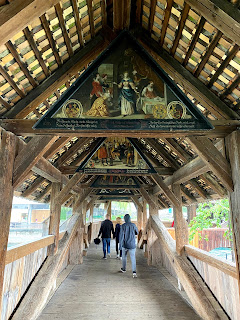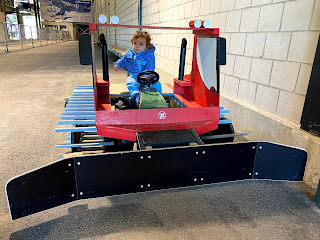A farmyard holiday in rural Canton Obwalden in Central Switzerland proves that we don't need to travel far to find a world removed. Pastoral landscapes, cobalt blue lakes and snowy summits set the scene for a week of pure R&R.
Our accommodation is an Airbnb in a 400-year-old barn that has been stylishly restored. It is clad in pine-toned shingle that looks like fluttering feathers. Inside, wizened wood partners with design elements - there's a glossy lacquered kitchen, a smart resin floor and huge panels of window that make the scenery outside look like artwork on the wall. The landscape is like Switzerland's answer to the Yorkshire Dales: tumbling meadows topple away into the Melch valley, scattered with lonesome farmhouses where shingle-facaded storey-upon-storey combines living space and barn.
The nearest town, Kerns, is about 20 minutes up from Lucerne but feels a million miles removed from the city. It's strung between famous Swiss sights - mounts Rigi, Pilatus and Stanserhorn, the Bürgenstock and Melchsee-Frutt.
Our first day in Vogelsang, as it is known, dawns wet, moody cloud tangled loosely around the mountains to give a mummifying effect. We practise yoga in front of the kitchen patio doors and walk along a farm track for views of the steely Lake Saarnen. Albie is beside himself with excitement at the cows and sheep in the fields, and squawks and shrieks - as he also does to sociable local cat Balu's horror.
It's grey and sullen on day two as well. but it makes us take life easy and we enjoy a walk around the turquoise Lake Lungern, where leafy hamlets that are a sort of real-life Hobbiton are studded into flanks that plunge into the water. Lungern has the feel of an old-fashioned seaside resort hunkered down for winter when the rain sweeps in for the afternoon.
More rain on our third day and the mountains have been painted out of the scene by a displeased artist. Balu the cat mews to be let inside. I don't blame him. But for some reason we always think wet days on countryside holidays are made for urban exploration... it is actually pretty grim pounding city streets in the drear. Nevertheless, Lucerne still looks desperately pretty: no dullness to the pastel-coloured townhouses that line the Reuss river and lake - I've never seen Lake Lucerne clad in anything other than cobalt blue, but on this day it was charcoal. No Alpine vista either, but the ever present charm of the medieval Kapellenbrücke with its flower boxes.
On another wet day, raindrops streaming like a shower and cloud strung in the treetops like cobwebs, we walk the panoramic path to Halten, between Vogelsang and Kerns. My eye is drawn by papal purple dark columbine. Each farmhouse has a well-tended vegetable patch with juicy lettuce, fennel and thyme. Cows peer from the shelter of their barns with curious, wide eyes and farm dogs growl to remind us of our place. It's bucolic and lovely.
At last, the promise of sunshine. At least, the cloud is loose enough to give glimpses of blue sky on our drive up the Glaubenberg Pass. As we set off on our hike, I stand and close my eyes and just listen. At first silence, then birdsong, then trickling water, before cowbells and a distant engine join the symphony. Our walk from Langis to Schlierengrat follows a wooded ridgline about as wide as a dragon's spine. The path is tangled in Alpine rose, and where the trees clear, cottongrass dances in meadows like sprites. Descending though moorland, the path is juicy and squelchy underfoot, and sprayed with flowers - yellow ox-eye, Alpine Bartsia, broad-leaved marsh orchid and common bistort. We pass pastures of cows grazing outside huts - quintessential Switzerland. The path concludes beside a bubbling brook the colour of whisky, where we stop to bask in the sun. I can hear cow bells, trickling water and insects.
Melchsee-Frutt on our final day offers a different type of Alpine scene - busy and tamed yet no less spectacular. A plateau at 1,800 metres above sea level, it is encircled by idiosyncratically shaped peaks - pointy and rounded and tabletop-like. Cobalt blue reservoirs complete the scene, today twinkling like the Mediterranean. There is such a gale blowing that we feel almost airborne on our hike up the Bonistock. Clusius gentian clusters to tinge the landscape indigo and our view stretches down the valley to the lowlands. It's a resort in the most literal sense - there's a hotel and a tourist train. Yet on foot and on the flanks of the mountains, the calm of trickling brooks can be heard.
We see out the holiday in the hotpot at the bottom of the garden, watching the light fade over the Glaubenberg Pass. We're not far from home but we feel a million miles removed. You don't always have to travel far to find the greatest escapism.
It's grey and sullen on day two as well. but it makes us take life easy and we enjoy a walk around the turquoise Lake Lungern, where leafy hamlets that are a sort of real-life Hobbiton are studded into flanks that plunge into the water. Lungern has the feel of an old-fashioned seaside resort hunkered down for winter when the rain sweeps in for the afternoon.
More rain on our third day and the mountains have been painted out of the scene by a displeased artist. Balu the cat mews to be let inside. I don't blame him. But for some reason we always think wet days on countryside holidays are made for urban exploration... it is actually pretty grim pounding city streets in the drear. Nevertheless, Lucerne still looks desperately pretty: no dullness to the pastel-coloured townhouses that line the Reuss river and lake - I've never seen Lake Lucerne clad in anything other than cobalt blue, but on this day it was charcoal. No Alpine vista either, but the ever present charm of the medieval Kapellenbrücke with its flower boxes.
On another wet day, raindrops streaming like a shower and cloud strung in the treetops like cobwebs, we walk the panoramic path to Halten, between Vogelsang and Kerns. My eye is drawn by papal purple dark columbine. Each farmhouse has a well-tended vegetable patch with juicy lettuce, fennel and thyme. Cows peer from the shelter of their barns with curious, wide eyes and farm dogs growl to remind us of our place. It's bucolic and lovely.
At last, the promise of sunshine. At least, the cloud is loose enough to give glimpses of blue sky on our drive up the Glaubenberg Pass. As we set off on our hike, I stand and close my eyes and just listen. At first silence, then birdsong, then trickling water, before cowbells and a distant engine join the symphony. Our walk from Langis to Schlierengrat follows a wooded ridgline about as wide as a dragon's spine. The path is tangled in Alpine rose, and where the trees clear, cottongrass dances in meadows like sprites. Descending though moorland, the path is juicy and squelchy underfoot, and sprayed with flowers - yellow ox-eye, Alpine Bartsia, broad-leaved marsh orchid and common bistort. We pass pastures of cows grazing outside huts - quintessential Switzerland. The path concludes beside a bubbling brook the colour of whisky, where we stop to bask in the sun. I can hear cow bells, trickling water and insects.
Melchsee-Frutt on our final day offers a different type of Alpine scene - busy and tamed yet no less spectacular. A plateau at 1,800 metres above sea level, it is encircled by idiosyncratically shaped peaks - pointy and rounded and tabletop-like. Cobalt blue reservoirs complete the scene, today twinkling like the Mediterranean. There is such a gale blowing that we feel almost airborne on our hike up the Bonistock. Clusius gentian clusters to tinge the landscape indigo and our view stretches down the valley to the lowlands. It's a resort in the most literal sense - there's a hotel and a tourist train. Yet on foot and on the flanks of the mountains, the calm of trickling brooks can be heard.
We see out the holiday in the hotpot at the bottom of the garden, watching the light fade over the Glaubenberg Pass. We're not far from home but we feel a million miles removed. You don't always have to travel far to find the greatest escapism.




































